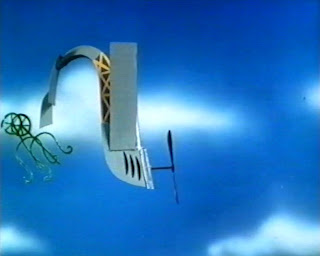Books on the history of British cinema often overlook animation. Raymond Durgnat's seminal 1970 volume A Mirror for England: British Movies from Austerity to Affluence is a key exception; after briefly touching upon Animal Farm and namechecking Dustbin Parade and Richard Williams during the course of the book he dedicates his final sub-chapter to the subject of animation in Britain.
He begins this overview by returning to Halas & Batchelor, specifically The Hoffnung Symphony Orchestra (which he credits with "spiritedly solving the problem which gave every Hollywood cartoon unit, from Disney to U.P.A., such difficulty; how to reconcile emphatic laugh gags with smartish post-Disney graphics") and Automania 2000.

The Rise and Fall of Emily Sprod. More stills here.
Durgnat then goes on to cover George Dunning's short films The Wardrobe, The Flying Man and The Apple, describing them as being "as near American wryness as any English tone", before going on to analyse the films of Bob Godfrey.
In a typical example of his characteristic writing style Durgnat describes The Do-It-Yourself Cartoon Kit as "a prestidigitous jingle-jumble of iconographies, from Goonish to Gothic, by way of empire-builders' emblems, admen's knickknacks, cultural doodads and assorted oojamaflips" before going on to make some very intriguing comments on the animator's potential future. Although Godfrey is now firmly associated with bawdy knockabout, Durgnat had something quite different in mind after discussing the proto-Gilliam visual style of The Rise and Fall of Emily Sprod:
The Rise and Fall of Emily Sprod... suggests that Godfrey might develop towards cartoons which are only incidentally humorous, and, primarily, dream-like, satirical, or even macabre, along the lines of the Polish school. For the Poles share the British ambivalence towards the past...
He then moves on to Richard Williams's Love Me, Love Me, Love Me and The Little Island. Of the former he has this to say:
If fratricidal strife, and ironies of cool and rage, are the covert theme of Tom and Jerry and the American cartoons, the corresponding English theme is a derisive nostalgia — not always the same thing as satire. Richard Williams's Love Me, Love Me, Love Me is a sharp send-up of British mediocrity as being self-protective masochism... all in all this cartoon is almost a classic crystallisation of the British character as Tex Avery's The Cat That Hated People of the American.
A Short Vision.
Finally, Durgnat concludes his book with a brief overview of Peter and Joan Foldes' Animated Genesis and A Short Vision:
The latter film, inspired by the irritatingly righteous, albeit naggingly plausible, spirit of C.N.D. insists, with its strong sculptural visuals, pointedly reminiscent of Henry Moore's wartime sketches of Londoners sleeping safely in tube shelters during the blitz, in making us feel, in skin and sinew, the unleashing of an atomic device that melts the bone under the face and snuffs the last spark of life from a blackened, superfluous, and shameful planet. The cartoon film, too, can be a moral sledgehammer.
One of Henry Moore's sketch Pink and Green Sleepers.




































































